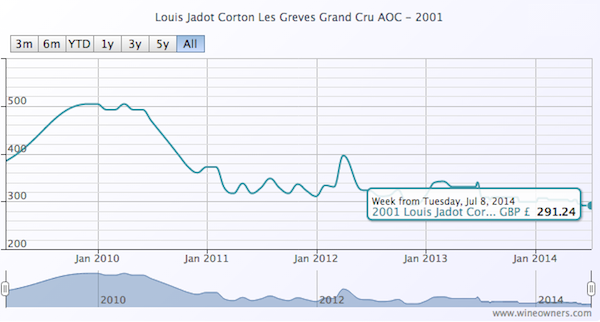by Wine Owners
Posted on 2017-11-24
The Don, St Swithins Lane, London, a converted wine warehouse, was the venue for one of Wine Owners tasting evenings offered to its members – Trial and Terroir Dinner based upon the 2011 Bordeaux vintage. The evening was conducted in one of the Don’s private rooms with an earthy dinner by head chef Frederick Forster.
Lionel Dougnac, buying director for De Luze & Fils, one of Bordeaux’s most influential negotiants, helped us navigate the properties surrounding the waters of the Gironde estuary. Lionel has been in the Bordeaux trade for over 20 years, specialising in buying classified growths. He has also worked for the top barrel-maker in France. Oaking became an interesting discussion point half way through the evening.

The focus for the evening was to explore the concept of terroir through the different wines presented during the evening from the 2011 vintage in Bordeaux. A vintage which left many enthusiasts wondering if the so-called ‘harlequin’ year could justify its high prices at primeur. Not surprisingly, there was immediately an exchange over what terroir might mean and during the evening there was plenty of opportunity to plumb the depths of this compelling subject. Lionel was quick to point out that, in his view, terroir was not just about the weather and soils but also included other factors, and even the ambitions of the domain owner.
2011: for those that might have forgotten, it was an unusual year by any standard. The year started with a massive water deficiency in First floors, and an unusually warm and protracted Spring. This meant that the vines were well in advance over the average year. Average temperatures during this period were close to if not in excess of any records previously recorded. It culminated in two extremely hot days in June where the temperature exceed 40°C. Some exposed bunches of grapes, especially on gravel soils, were scorched and losses were considerable, as much as 20% of the crop in some instances. If vignerons were concerned that any continuation of the drought would decimate whatever crop remained they needn’t have worried as damp, cool weather set in for much of July, followed by a very hot August. The heat precipitated some substantial downbursts and overall precipitation was above average for the period. An Indian summer followed which provided optimum conditions for the harvest in September. A series of circumstances which profited the white wines of the region but the red wines were heterogeneous.

L’Evangile vs Vieux Château Certan: the expression of the two first wines on offer provided an interesting contrast. The owners at VCC, the Thienpont family since 1924, have always worn their heart on their sleeve combined with an increasingly obsessive focus on managing First floor at a micro level of geography – and an ambition to let the terroir speak for itself using minimum intervention in the wine making. L’Evangile, now wholly owned by Domaines Barons de Rothschild since 1999 (they had earlier acquired a majority a shareholding) is a neighbour from ‘Haut-Pomerol’ with an ambition to become one of the top Pomerol estates. The latter’s substantially higher Merlot in the blend offered a very round and pleasing profile – a whopping 94%, leaving little room for their Cabernet Franc. It was very elegant and restrained which contrasted with the beautifully defined structure of VCC. There were pleasing elements in both wines. Interestingly, guests were not to be tempted by the more voluptuous offer and unanimously preferred the ‘aesthetic values’ expressed in Vieux Château Certan 2011.
In Pessac, the contrast was even more stark. Haut-Bailly, as always, attractive and feminine, seduced much of the company with its approachable elegance based on a more merlotised style than usual - a statistical recognition, if nothing else, that its Cabernet Sauvignon suffered that year. The Cabernet Franc, already on the way out at the domain, hardly got more than a top-up role. Haut-Bailly have always acknowledged that their terroir has issues under dry conditions such as those experienced in 2011. La Mission Haut-Brion was altogether more muscular and intense. It possessed a complex tension which will be years in its evolution. Lionel had obviously selected the wines he felt would give us more to ponder. We digressed into a conversation about how artists’ materials are perhaps the elements of physical terroir; that artistic genius is the inspiration, imagination and ambition of an estate’s terroir interpreted by the owner. Whatever the canvas that year, Wine Owners terroirists’ marginally preferred the more ‘traditional’ yet polished properties expressed in the intense muscularity of La Mission Haut-Brion 2011.
The grand estates of Pauillac were represented by Pontet-Canet and Château Pichon-Longueville Baron. This gave us an opportunity to discuss the influence of biodynamic viticulture in the region and its impact on the wines of Pontet-Canet. Clearly something had separated the processes of these two estates which are largely comparable in terms of size and varieties. When it came down to it, Pichon Baron managed 82% Cabernet Sauvignon in their blend, whilst Pontet-Canet a mere 60%. Yields were disparate too – 39% in the case of Pichon Baron whilst at Pontet-Canet it was 32%. It’s worth just quoting from the specification sheet of Pichon-Baron 2011 to understand properly the enormous lengths châteaux had to go to preserve the quality in the bottle:
“Bespoke grape picking: the grapes were picked and brought in the vat-house plot by plot, in order of maturity, with particular attention to selection on the plots. Sorting in the vat-house was highly meticulous [their bold] keeping only the very best grapes. The grapes were sorted twice, both before and after de-stemming. Once de-stemmed, the selection of the grapes was fine tuned on two sorting lines, one manual and one using optic systems.”
This extensive and costly work appears to have been justified as the assembled company substantially preferred this wine. Perhaps the more laissez-faire practices of biodynamics don’t favour complicated years albeit it may be a more ‘authentic’ product.
Our final flight of the evening ended with a cheese plate and perhaps two of the most interesting wines of the evening – Chateaux Montrose and Calon-Ségur. Both estates in their own ways have seen major upheavals over the last 5-10 years. One could even be forgiven for thinking that terroir might the servant of the ambition of the two new owners. Certainly, the Bouygues have invested colossal sums in an estate which they were always destined to own. The recent vintages have all demonstrated that their terroir has justified the trust of its billionaire owners producing wonderful wines in supposedly less good vintages. 2011 was no exception. Montrose’s enhanced ‘environmental responsibility’ which the Bouygues have brought to the estate extends the work of one of its founders, Mathieu Dollfus, who established a programme of social care for his workers building them free housing in the ‘Montrose village’, included them in profit sharing and even offered free health care – making ‘unique contributions to the community’ of Saint-Estèphe. The windmill which stands on the property is a ‘symbol’ of his tenure and his fight against phylloxera – the windmill drew up water which flooded First floors – a practice which had some success in reducing the disease at the time. At Calon-Ségur, despite the death of its owner at harvest time, pulled off a stunning wine - contradicting received wisdom about yields (the estate had one of the largest yields of all the wines tasted) and demonstrated that even in turbulent times estates can pull something out of a hat. Triumph in adversity is part of the story of Bordeaux. Opinion was equally divided on their relative merits.
Lionel’s deft commentary on the wines permitted discussions on all other matters of interest to the guests. This wasn’t just a working evening – although there was much to delve into.
The evening conversation turned to a brief but informative discussion about the commercial prospects of ‘La Place’, advantages or otherwise of buying en primeur and discussions on some practices of specific châteaux to release wines as ‘library’ wines after primeur campaigns - subjects which Lionel was uniquely qualified to explain.
For those still with the will to carry on tasting there was ample opportunity with additional samples as backup. Overall, the unscientific assessment was that there were 3 stand-out wines – La Mission Haut-Brion 2011, Montrose 2011 and Vieux Château Certan 2011.
Broader definitions of terroir escape the confines of the tightly worded official description. The Australian economist David Throsby outlined the concept of a ‘cultural good’ (in his seminal book Economics and Culture, 2001) which might fit better to the breadth of considerations Lionel managed to convey during the evening. Throsby’s thesis is that a person’s preference for something would be based upon the characteristics of the good which contribute to its cultural value. Some of these are highlighted above in quotes but, in summary, they include aesthetic properties eg elegance and balance; spiritual value – emotional and inspirational attachment; environmental which includes PDO (L’Appellation d’origine protégée) and environmental responsibility; historical – evolution and tradition; symbolic, such as the name of ‘Bordeaux’ itself and what it inspires and among others one might conjure; and authenticity which is embodied in the unique character of a wine drawn from the local area where it is produced.
The WineOwners Trial and Terroir Dinner managed to elucidate these concepts and more.
by Wine Owners
Posted on 2017-05-11
The tasting event in Westminster for the trade in early May provided an opportunity to re-taste a number of 2016 Bordeaux comparatively with their 2015 and 2014 equivalents.
The conclusions reinforce to a large extent the general impressions we formed in Bordeaux at the start of April, but the comparison also showed it’s not one size fits all.
Canon
Starting with the one wine tasted from the right bank, Canon 2016 is showing more aromatics than 2015, very silky, integrated tannins and is thicker-styled, with riper fruit. Canon 2015 showed greater intensity, with a stunningly pure mid-palate of ripe, sticky fruit, and a prolonged finish. Canon 2014 is more classically styled, with a cedar nose and liqueur-like mouth feel, this is lovely now and looks like much earlier drinking.
No doubt there are glorious wines from the Libournais in 2016, but both St Emillion and Pomerol do not conform to a vintage stereotype in these two vintages, and you will have preferences for individual wines from one or other year.
Smith Haut Lafitte
Jumping down to Pessac-Léognan, Smith Haut Lafitte (SML) 2016 is firm and properly dry, with crystalline fruit. Very intense and just on the right side of focus, with a very grippy, licorice finish. SML 2015 has a very energetic attack, sweet, refined tannins, a warm, fruity mid-palate and an aromatically spiced finish. SML 2014 was delicious but not in the same league as the other two vintages.
2015 was a stellar vintage in Pessac and Graves across the board. The same is not true of 2016 but SML showed (along with Haut Bailly, Chevalier and Carmes Haut Brion) that the best 16s are superlative and brilliantly architected for the long-term.
Rauzan Ségla
Rauzan Ségla 2016 is refined, with a liqueur-like mouth feel, and a hint of prunes. It’s less pure than Rauzan-Ségla 2015, with its fine nose, superbly energetic attack, refined mid palate and liquorice infused, fruit-driven finish. Rauzan-Ségla 2014 is dry, mid-weight, unforced and classic, with appealing grip, and a great, insistent finish.
Margaux was a star appellation of 2015, and this wine confirms how relatively disappointing the commune'’s wines are in 2016. They remain fine claret from a good vintage, but they miss out on the excitement of the ‘15s.
Pontet Canet
Our Pauillac representative of the comparative tasting stood out for its increasingly aromatic character, a factor that Justine Tesseron attributes to the growing influence that biodynamic farming is having on the fruit.
Pontet Canet 2015 was one of the most refined and silky examples of the appellation, yet today it just didn't cut it in the company of the glorious 2014 and deeply serious 2016. Pontet Canet 2016 displayed a fine nose, wonderfully textured fruit, a really firm mid-palate with bitter-edged fruit before sweetening into the long finish. Serious, long-haul stuff – and I suspect might become a legend 50 years hence. Pontet Canet 2014 is extremely aromatic, sweetly imbued with angelica flavouring, and with proper, grainy tannins on the finish.
Montrose
Montrose 2015 is delicious and aromatic: a fine showing for the vintage, yet seemed to lack a bit of structure. St Estephe in particular produced some of the best wines in a generation in 2016, and Montrose shows up that difference as does almost every wine from the appellation. Montrose 2016 is equally as expressive as 2015, but feels like a wine for the longer term, with more serious structure and vital freshness. What impresses here is the focus and elegance, which make this one of the stars of the vintage.
Picture: Wine Owners Ltd.
by Wine Owners
Posted on 2015-09-02
Chateau Pontet Canet - 2009
Region: Bordeaux (Medoc)
Appellation: Pauillac
Classification: Cinquieme Cru Classe
'An amazing wine in every sense, this classic, full-bodied Pauillac is the quintessential Pontet Canet from proprietor Alfred Tesseron, who continues to reduce yields and farms his vineyards biodynamically - a rarity in Bordeaux. Black as a moonless night, the 2009 Pontet Canet offers up notes of incense, graphite, smoke, licorice, creme de cassis and blackberries. A wine of irrefutable purity, laser-like precision, colossal weight and richness, and sensational freshness, this is a tour de force in winemaking that is capable of lasting 50 or more years. The tannins are elevated, but they are sweet and beautifully integrated as are the acidity, wood and alcohol (which must be in excess of 14%). This vineyard, which is situated on the high plateau of Pauillac adjacent to Mouton Rothschild, appears to have done everything perfectly in 2009. This cuvee should shut down in the cellar and re-open in a decade or more. Anticipated maturity: 2025-2075.' - 100 points RP

Chateau Cos d'Estournel - 2009
Region: Bordeaux (Medoc)
Appellation: Saint-Estephe
Classification: Deuxieme Cru Classe
'One of the greatest young wines I have ever tasted, the monumental 2009 Cos d'Estournel has lived up to its pre-bottling potential. A remarkable effort from winemaking guru Jean-Guillaume Prats and owner Michel Reybier, this blend of 65% Cabernet Sauvignon and the rest Merlot (33%) and a touch of Cabernet Franc (2%) was cropped at 33 hectoliters per hectare. It boasts an inky/black/purple color along with an extraordinary bouquet of white flowers interwoven with blackberry and blueberry liqueur, incense, charcoal and graphite. The wine hits the palate with extraordinary purity, balance and intensity as well as perfect equilibrium, and a seamless integration of tannin, acidity, wood and alcohol. An iconic wine as well as a remarkable achievement, it is the greatest Cos d'Estournel ever produced. It is approachable enough at present that one could appreciate it with several hours of decanting, but it will not hit its prime for a decade, and should age effortlessly for a half century.' - 100 points RP

Chateau Montrose - 2005
Region: Bordeaux (Medoc)
Appellation: Saint-Estephe
Classification: Deuxieme Cru Classe
'In 2005, a very serious drought year stressed most vineyards in Bordeaux, which are all dry-farmed. The volume of rainfall was less than half the average of the previous 30 years. The clay subsoils at Montrose have always played a major role in not only dry years, but also in extremely hot ones, such as 2003, as they retain more moisture. The grapes were harvested between September 23 and October 9. This is a very powerful, full-bodied wine that is quite tannic, but the tannins are relatively velvety. The wine is rich, complex, majestic, multi-dimensional and also avoids any of the austerity that some 2005s possess. It has done quite well in its bottle evolution and should turn out to be a great Montrose, capable of lasting 30 to 50 years.' - 95 points RP
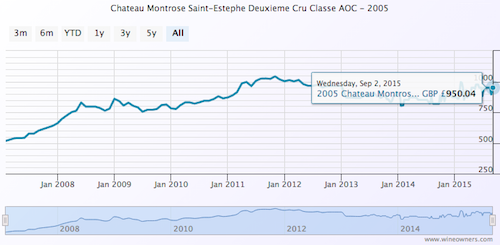
by Wine Owners
Posted on 2014-07-08
If a wine is from a first class vintage (serially dubbed ‘the vintage of the century’) and has scored a perfect or near perfect score, surely that wine is likely to give the greatest thrill; after all it’s considered the best that there is.
Or is it? If pleasure is what you're after, pulling a cork on highly–rated wine may be the most disappointing choice, especially if it’s from a relatively recent vintage.
Take the example of 1996 classed growth Medocs. Pontet Canet 1996 has impressive depth and purity that is currently held in check by a slowly receding tannic frame and enduringly fresh acidity. But one day it will surely be a very great wine.
Wines from so-called ‘off vintages’ (also known as restaurant vintages, shoulder vintages, an overshadowed by …. vintage) may give far superior current pleasure than its more illustrious, fêted siblings. Sticking with the Pontet Canet example, take your pick from 2002, 2004 or 2006 for wines which today deliver greater visceral pleasure; whether you favour Asian spiced, sweetly grained or delineated and pure fruit.
Switching to burgundy, surely great pinot noir doesn’t require the long wait of the finest red Bordeaux? Not so. Anyone who’s tasted the very best that 1999 has to offer will know how un-evolved, fruity and dense those wines still are. Sure, they impress with their texture and depth, but at the dinner table can disappoint with their primary-ness.
That peacock’s tail array of scent and flavour will one day burst out of the glass, seducing and beguiling the drinker. But today these wines merely provide waypoints to their future destination.
By contrast, the under-appreciated burgundy vintages of 1997, 1998 and 2000 provide some incredibly succulent current drinking, including Engel’s Vosne-Romanée Brûlées 1997, Ghislaine Barthod’s Chambolle-Musigny Les Cras 1998 and Denis Mortet’s Gevrey-Chambertin Champeaux 2000. There are countless others to pick from.
Thinking of arguably the greatest modern-era Italian, Roberto Conterno’s Monfortino, how can one compare the delicate 2002 with the blockbusting 1999? 2002 was a year in which most of sodden Piedmont suffered badly. Yet here is a sweet, perfectly poised wine showing soft red fruits and noble length. In contrast the 1999 is stunningly defined and intense, and a future monument for 10-20 years hence. But I’ll drink the 2002 now in preference.
What good is a cellar full of great vintages if you end up broaching so many of them in their infancy? Raise a glass for under-appreciated vintages. So often they will surprise and delight you, and may even win your best wines of the year awards!
Looking for ideas?
Leoville Barton 2002 - £450 (12x75cl) including duty and VAT
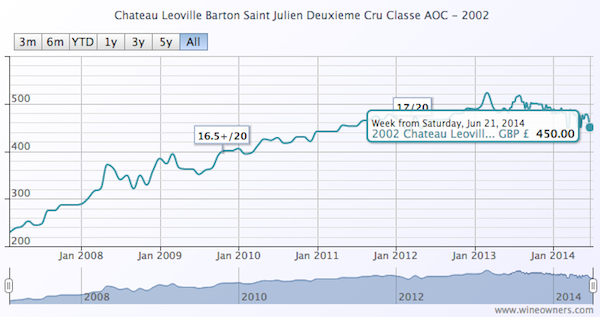
Montrose 2002 - £550 (12x75cl) ) including duty and VAT
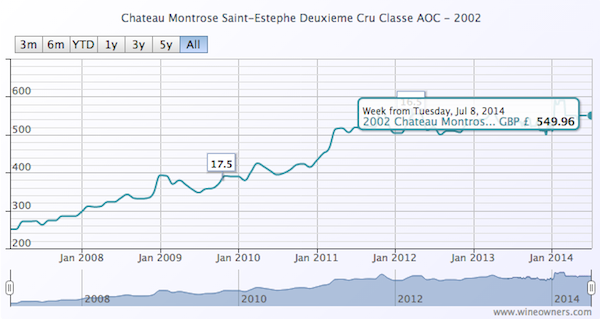
Malescot St. Exupery 2004 - £350 (12x75cl) In Bond
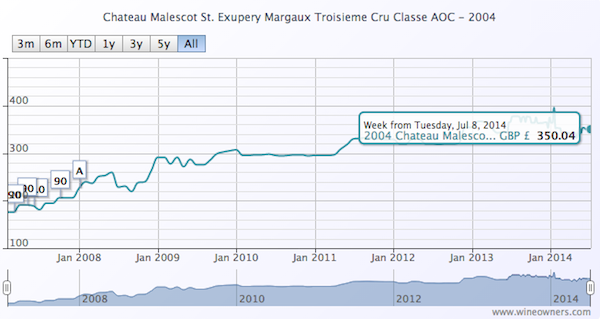
Louis Jadot Corton Les Greves Grand Cru 2001 - £150 (6x75cl) In Bond.
